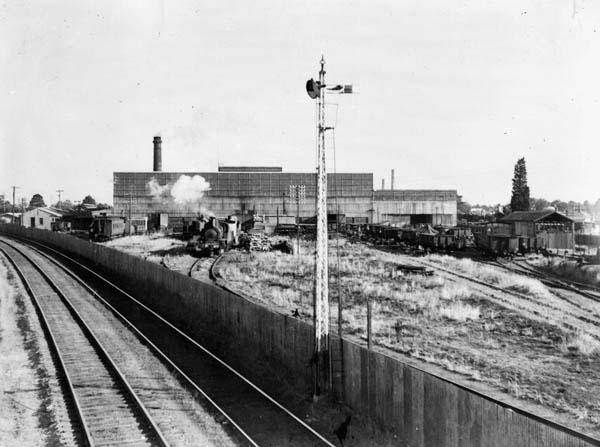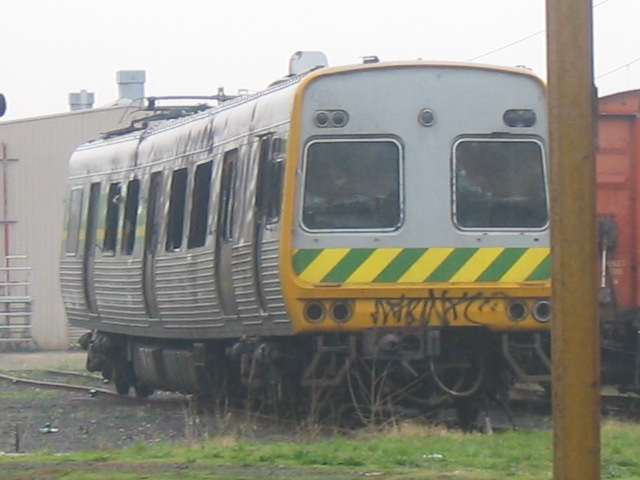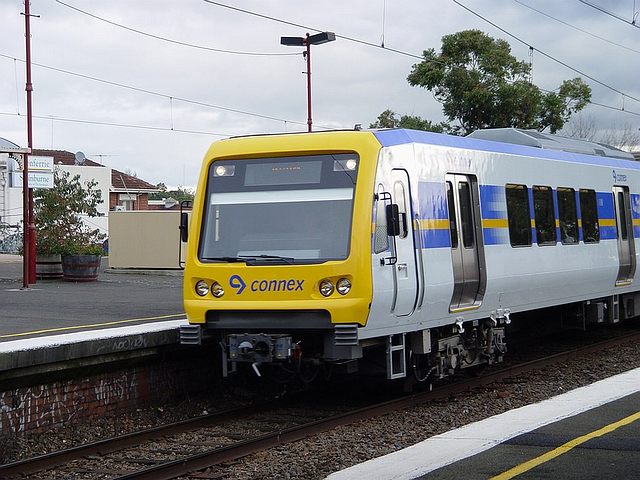|
Ballarat North Workshops
Ballarat North Workshops is a railway systems engineering facility located in the provincial city of Ballarat, Victoria, Australia. They are located in the suburb of Soldiers Hill on Creswick Road, and occupy 5.5 hectares of land beside the junction of the Mildura and Serviceton railway lines. History The workshops were opened in April 1917 by the main rail operator in Victoria, the Victorian Railways. They were opened in response to political pressures from provincial groups for decentralisation, with the Victorian Railways preferring the cheaper option of expanding the existing Newport Workshops in suburban Melbourne. The main work carried out was repairs and maintenance of existing wagons and locomotives, but from 1919-22 thirteen new steam locomotives were also built - eight DD class (1038 - 1042, 1050 - 1052) and five A2 class (1073 - 1077) steam locomotives were also built. By the 1960s goods wagons were also being built, and by the 1980s work was also being carried out ... [...More Info...] [...Related Items...] OR: [Wikipedia] [Google] [Baidu] |
Ballarat North Workshops
Ballarat North Workshops is a railway systems engineering facility located in the provincial city of Ballarat, Victoria, Australia. They are located in the suburb of Soldiers Hill on Creswick Road, and occupy 5.5 hectares of land beside the junction of the Mildura and Serviceton railway lines. History The workshops were opened in April 1917 by the main rail operator in Victoria, the Victorian Railways. They were opened in response to political pressures from provincial groups for decentralisation, with the Victorian Railways preferring the cheaper option of expanding the existing Newport Workshops in suburban Melbourne. The main work carried out was repairs and maintenance of existing wagons and locomotives, but from 1919-22 thirteen new steam locomotives were also built - eight DD class (1038 - 1042, 1050 - 1052) and five A2 class (1073 - 1077) steam locomotives were also built. By the 1960s goods wagons were also being built, and by the 1980s work was also being carried out ... [...More Info...] [...Related Items...] OR: [Wikipedia] [Google] [Baidu] |
Alstom
Alstom SA is a French multinational rolling stock manufacturer operating worldwide in rail transport markets, active in the fields of passenger transportation, signalling, and locomotives, with products including the AGV, TGV, Eurostar, Avelia and New Pendolino high-speed trains, in addition to suburban, regional and metro trains, and Citadis trams. Alsthom (originally Als-Thom) was formed by a merger between Compagnie Française Thomson-Houston and the electric engineering division of Société Alsacienne de Constructions Mécaniques in 1928. Significant later acquisitions included the Constructions Electriques de France (1932), shipbuilder Chantiers de l'Atlantique (1976), and parts of ACEC (Belgium, late-1980s). A merger with parts of the General Electric Company (UK) formed GEC Alsthom in 1989. Throughout the 1990s, the company expanded its holdings in the rail sector, via the acquisition of German rolling stock manufacturer Linke-Hofmann-Busch and Italian rail signall ... [...More Info...] [...Related Items...] OR: [Wikipedia] [Google] [Baidu] |
Locomotive Under Construction
A locomotive or engine is a rail transport vehicle that provides the motive power for a train. If a locomotive is capable of carrying a payload, it is usually rather referred to as a multiple unit, motor coach, railcar or power car; the use of these self-propelled vehicles is increasingly common for passenger trains, but rare for freight (see CargoSprinter). Traditionally, locomotives pulled trains from the front. However, push-pull operation has become common, where the train may have a locomotive (or locomotives) at the front, at the rear, or at each end. Most recently railroads have begun adopting DPU or distributed power. The front may have one or two locomotives followed by a mid-train locomotive that is controlled remotely from the lead unit. __TOC__ Etymology The word ''locomotive'' originates from the Latin 'from a place', ablative of 'place', and the Medieval Latin 'causing motion', and is a shortened form of the term ''locomotive engine'', which was first ... [...More Info...] [...Related Items...] OR: [Wikipedia] [Google] [Baidu] |
Train Protection & Warning System
The Train Protection & Warning System (TPWS) is a train protection system used throughout the British passenger main-line railway network, and in Victoria, Australia. The British Rail Safety and Standards Board's definition is: The purpose of TPWS is to stop a train by automatically initiating a brake demand, where TPWS track equipment is fitted, if the train has: *passed a signal at danger without authority *approached a signal at danger too fast *approached a reduction in permissible speed too fast *approached buffer stops too fast. TPWS is not designed to prevent SPADs but to mitigate the consequences of a SPAD, by preventing a train that has had a SPAD from reaching a conflict point after the signal. A standard installation consists of an on-track transmitter adjacent to a signal, activated when the signal is at danger. A train that passes the signal will have its emergency brake activated. If the train is travelling at speed, this may be too late to stop it before the point ... [...More Info...] [...Related Items...] OR: [Wikipedia] [Google] [Baidu] |
X'Trapolis 100
The X'Trapolis 100 is a class of single deck electric multiple units part of Alstom's X'Trapolis family of trains, operated in Melbourne, Victoria, Australia and Valparaíso, Chile. Melbourne In service When originally introduced to the suburban network in 2002, the trains operated only on the former Hillside network (consisting of the Burnley and Clifton Hill group lines), and did not run revenue services elsewhere operated by M>Train on the Bayside Trains half of the system. Although the networks merged in 2004, when Connex took over all operations, the X'trapolis units did not operate on the Bayside system at the time. On 22 October 2014, the operation of X'Trapolis 100 trains was expanded to include lines on the former Bayside Trains network with the Frankston line being cleared for their operation and initially running two weekday morning-peak services. On 20 November 2016, X'Trapolis 100 trains were expanded to full-time running on the Frankston line and began oper ... [...More Info...] [...Related Items...] OR: [Wikipedia] [Google] [Baidu] |
Hitachi (Australian Train)
The Hitachi (also known as Martin & King or Stainless Steel) was an electric multiple unit that operated on the Melbourne suburban railway network between 1972 and 2014. Electrical equipment was supplied by Commonwealth Engineering to designs by Hitachi of Japan, leading to their official name today, though no actual Hitachi-supplied components were used in their construction. They were the last suburban trains in Melbourne with no air conditioning. A total of 355 carriages were built between 1972 and 1981, including a replacement carriage for one written off while the fleet was still being delivered. Configuration Based on a successful trial of longer Harris trailer cars built between 1967 and 1971, the Hitachi used carriages long, up from the standard length of the earlier suburban cars. The revised carriage design enabled a six car Hitachi to seat 560 passengers, up from 540 for a seven car Harris, and allowed a maximum load of 1,500 passengers, 300 more than a Harris ... [...More Info...] [...Related Items...] OR: [Wikipedia] [Google] [Baidu] |
Comeng (train)
The Comeng train ( ) is a type of electric multiple unit (EMU) that operates on the suburban railway network of Melbourne, Victoria, Australia. Built by Commonwealth Engineering (Comeng) in Dandenong, they were introduced in 1981 as a replacement for the Tait and Harris trains. In total, 570 carriages (380 motor cars and 190 trailer cars, a total of 95 six carriage sets) were built. Description Comeng trains are single deck and are semi-permanently coupled as M-T-M (motor-trailer-motor) sets. Most frequently, they are coupled as M-T-M-M-T-M (six-car) sets. Comeng trains have power operated doors that must be pulled open by hand but are closed by the driver. The trains were the first suburban trains in Melbourne to have air-conditioning in the passenger saloon. (The older Hitachi trains had driver only air-conditioning fitted more recently.) They operate in larger numbers on the Northern, Caulfield, Cross City and Sandringham group lines, and since 2017 it has been rare to ... [...More Info...] [...Related Items...] OR: [Wikipedia] [Google] [Baidu] |
Connex Melbourne
Connex Melbourne was a train operator in Melbourne, Australia. Formed in October 1997 as Hillside Trains, a business unit of the Public Transport Corporation, it was privatised in August 1999 becoming a subsidiary of Connex. In April 2004, it became the sole operator of Melbourne suburban rail services, taking over the services of M>Train. When the franchise was re-tendered, it was awarded to Metro Trains Melbourne from November 2009. History On 1 October 1997, in preparation for privatisation, the Public Transport Corporation's suburban rail operations were split into two business units, Bayside Trains and Hillside Trains. The latter took over operation of the Lilydale, Belgrave, Alamein, Glen Waverley, Epping (now Mernda) and Hurstbridge line services. Connex successfully bid to take over the Hillside Trains services from 29 August 1999 beating competition from GB Railways and National Express. It was rebranded Hillside Trains as Connex Melbourne in July 2000."Connex ... [...More Info...] [...Related Items...] OR: [Wikipedia] [Google] [Baidu] |
CFCL Australia
Rail First Asset Management (RailFirst), formerly known as CFCL Australia (CFCLA), is an Australian rolling stock leasing company operating in the rail freight market. It leases assets to a number of private rail operators in the local rail industry, predominantly on the defined interstate rail network. Though primarily based in New South Wales, RailFirst's assets can be found operating in most Australian states and with all major train operating companies. It has rolling stock on both long-term lease to these companies as well as assets that are available for spot hire. It is owned by Anchorage Capital Partners. History CFCL Australia was established in 1998, by the American Chicago Freight Car Leasing Company. Its first contract was for the supply of a small fleet of radio controlled, automated ballast hoppers to Westrail. The first locomotives acquired were 13 members of the EL class from Australian National in November 1998. In 2000, it diversified into wagons. In Mar ... [...More Info...] [...Related Items...] OR: [Wikipedia] [Google] [Baidu] |
Pacific National
Pacific National is one of Australia's largest rail freight businesses. History In February 2002, National Rail Corporation, National Rail's freight operations and rollingstock (owned by the Government of Australia, Federal, Government of New South Wales, New South Wales and Government of Victoria (Australia), Victorian Governments) were combined with FreightCorp (owned by the New South Wales Government) and sold to a joint venture between Patrick Corporation and Toll Holdings as Pacific National. In February 2004, Pacific National purchased Australian Transport Network, operator of ATN Access and AN Tasrail. In August 2004, Pacific National purchased Freight Australia, giving Pacific National control of the Victorian non-urban rail track, excluding the interstate network which is controlled by the Australian Rail Track Corporation. As part of the sale conditions, the Australian Competition and Consumer Commission attached special conditions to the sale to ensure competition ... [...More Info...] [...Related Items...] OR: [Wikipedia] [Google] [Baidu] |
V/Line
V/Line is a statutory authority that operates regional passenger train and coach services in Victoria, Australia. It provides passenger train services on five commuter lines and eight long-distance routes from its major hub at Southern Cross railway station in Melbourne, as well as bus services across Victoria and into New South Wales, the Australian Capital Territory and South Australia. In addition, V/Line is responsible for the maintenance of much of the Victorian freight and passenger rail network outside of the areas managed by Metro Trains Melbourne and the Australian Rail Track Corporation. The V/Line brand was introduced after the split-up of VicRail in 1983, and has been used by all successive government and private operators of the state's regional public transport. Until 1999, when its freight operations were privatised, V/Line Freight was also a monopoly government provider of the state's rail freight services. Since 2004, V/Line Pty Ltd, the main operating rail ... [...More Info...] [...Related Items...] OR: [Wikipedia] [Google] [Baidu] |
Trams In Melbourne
Trams are a major form of public transport in Melbourne, the capital city of the state of Victoria, Australia. As of May 2017, the Melbourne tramway network consists of of double track, 493 trams, 24 routes, and 1,763 tram stops. The system is the largest operational urban tram network in the world. Trams are the second most used form of public transport in overall boardings in Melbourne after the commuter railway network, with a total of 206 million passenger trips in 2017–18. Trams have operated continuously in Melbourne since 1885 (the horse tram line in Fairfield opened in 1884, but was at best an irregular service). Since then they have become a distinctive part of Melbourne's character and feature in tourism and travel advertising. Melbourne's cable tram system opened in 1885, and expanded to one of the largest in the world, with of double track. The first electric tram line opened in 1889, but closed only a few years later in 1896. In 1906 electric tram syste ... [...More Info...] [...Related Items...] OR: [Wikipedia] [Google] [Baidu] |








